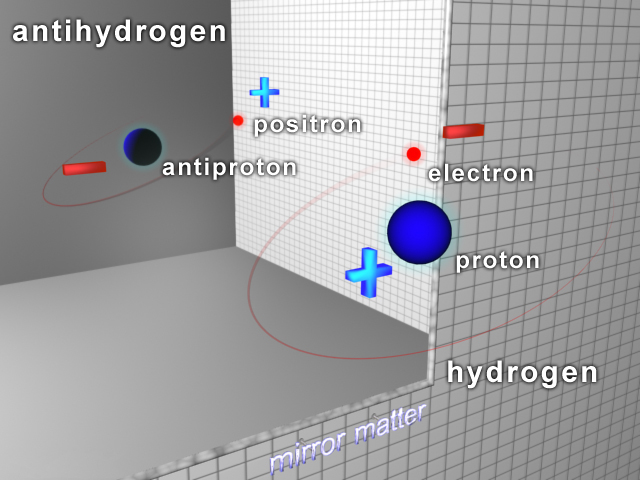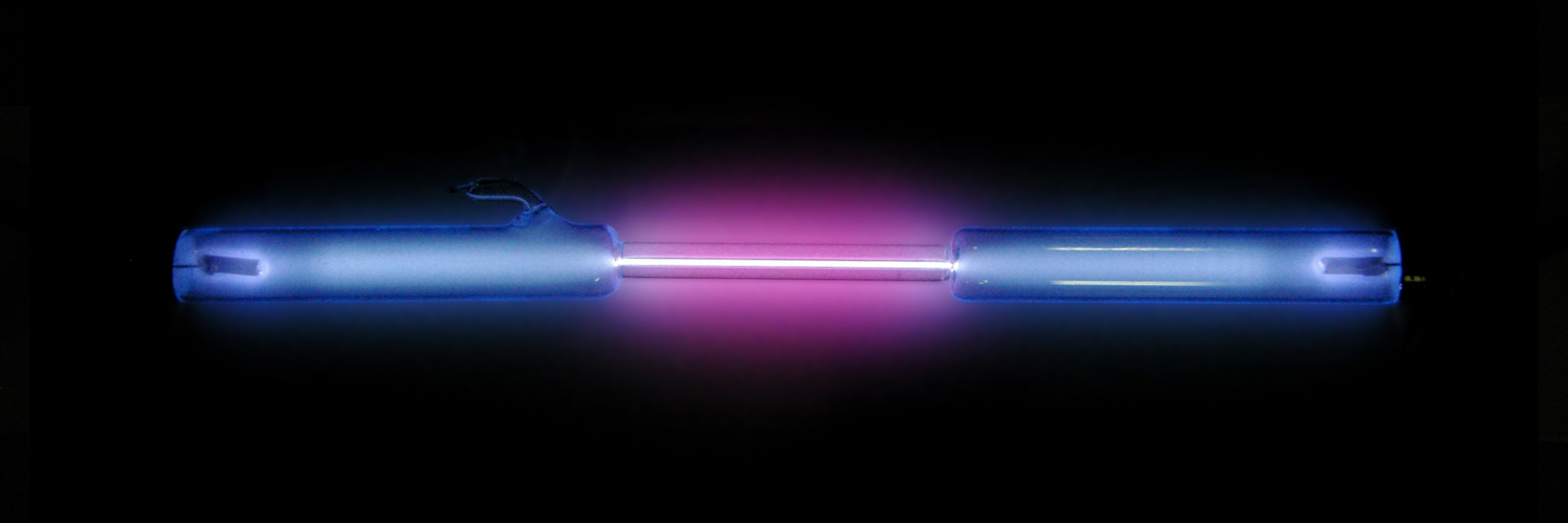|
Antihydrogen
Antihydrogen () is the antimatter counterpart of hydrogen. Whereas the common hydrogen atom is composed of an electron and proton, the antihydrogen atom is made up of a positron and antiproton. Scientists hope that studying antihydrogen may shed light on the question of why there is more matter than antimatter in the observable universe, known as the baryon asymmetry problem. Antihydrogen is produced artificially in particle accelerators. Experimental history Accelerators first detected hot antihydrogen in the 1990s. ATHENA studied cold in 2002. It was first trapped by the Antihydrogen Laser Physics Apparatus (ALPHA Collaboration, ALPHA) team at CERN in 2010, who then measured the structure and other important properties. ALPHAAEgIS and GBAR plan to further cool and study atoms. 1s–2s transition measurement In 2016, the Antiproton Decelerator#ALPHA, ALPHA experiment measured the atomic electron transition between the two lowest energy levels of antihydrogen, 1s–2s. The ... [...More Info...] [...Related Items...] OR: [Wikipedia] [Google] [Baidu] |
Antiproton Decelerator
The Antiproton Decelerator (AD) is a storage ring at the CERN laboratory near Geneva. It was built from the Antiproton Collector (AC) to be a successor to the Low Energy Antiproton Ring (LEAR) and started operation in the year 2000. Antiprotons are created by impinging a proton beam from the Proton Synchrotron on an iridium target. The AD decelerates the resultant antiprotons to an energy of 5.3 MeV, which are then ejected to one of several connected experiments. The major goals of experiments at AD are to Spectroscopy, spectroscopically observe the antihydrogen and to study the effects of gravity on antimatter. Though each experiment at AD has varied aims ranging from testing antimatter for cancer therapy to CPT symmetry and Anti-gravity, antigravity research. History From 1982 to 1996, CERN operated the Low Energy Antiproton Ring, Low Energy Antiproton Ring (LEAR), through which several experiments with slow-moving antiprotons were carried out. During the end stages of LEAR ... [...More Info...] [...Related Items...] OR: [Wikipedia] [Google] [Baidu] |
Antimatter
In modern physics, antimatter is defined as matter composed of the antiparticles (or "partners") of the corresponding subatomic particle, particles in "ordinary" matter, and can be thought of as matter with reversed charge and parity, or going backward in time (see CPT symmetry). Antimatter occurs in natural processes like cosmic ray collisions and some types of radioactive decay, but only a tiny fraction of these have successfully been bound together in experiments to form antiatoms. Minuscule numbers of antiparticles can be generated at particle accelerators, but total artificial production has been only a few nanograms. No Macroscopic scale, macroscopic amount of antimatter has ever been assembled due to the extreme cost and difficulty of production and handling. Nonetheless, antimatter is an essential component of widely available applications related to beta decay, such as positron emission tomography, radiation therapy, and industrial imaging. In theory, a particle and ... [...More Info...] [...Related Items...] OR: [Wikipedia] [Google] [Baidu] |
Gravitational Interaction Of Antimatter
The gravitational interaction of antimatter with matter or antimatter has been observed by physicists. As was the consensus among physicists previously, it was experimentally confirmed that gravity attracts both matter and antimatter at the same rate within experimental error. Antimatter's rarity and tendency to annihilate when brought into contact with matter makes its study a technically demanding task. Furthermore, gravity is much weaker than the other fundamental forces, for reasons still of interest to physicists, complicating efforts to study gravity in systems small enough to be feasibly created in lab, including antimatter systems. Most methods for the creation of antimatter (specifically antihydrogen) result in particles and atoms of high kinetic energy, which are unsuitable for gravity-related study. Antimatter is gravitationally attracted to matter. The magnitude of the gravitational force is also the same. This is predicted by theoretical arguments like the grav ... [...More Info...] [...Related Items...] OR: [Wikipedia] [Google] [Baidu] |
ALPHA Collaboration
The Antihydrogen Laser Physics Apparatus (ALPHA), also known as AD-5, is an experiment at CERN's Antiproton Decelerator, designed to trap antihydrogen in a magnetic trap in order to study its atomic spectra. The ultimate goal of the experiment is to test CPT symmetry through comparing the respective spectra of hydrogen and antihydrogen. Scientists taking part in ALPHA include former members of the ATHENA experiment (AD-1), the first to produce cold antihydrogen in 2002. On 27 September 2023, ALPHA collaborators published findings suggesting that antimatter interacts with gravity in a way similar to regular matter, supporting a prediction of the weak equivalence principle. Experimental setup Working with antimatter presents several experimental challenges. Magnetic traps—wherein neutral atoms are trapped using their magnetic moments—are required to keep antimatter from annihilating with matter, but are notoriously weak. Only atoms with kinetic energies equivalent to les ... [...More Info...] [...Related Items...] OR: [Wikipedia] [Google] [Baidu] |
Hydrogen
Hydrogen is a chemical element; it has chemical symbol, symbol H and atomic number 1. It is the lightest and abundance of the chemical elements, most abundant chemical element in the universe, constituting about 75% of all baryon, normal matter. Under standard conditions, hydrogen is a gas of diatomic molecules with the chemical formula, formula , called dihydrogen, or sometimes hydrogen gas, molecular hydrogen, or simply hydrogen. Dihydrogen is colorless, odorless, non-toxic, and highly combustible. Stars, including the Sun, mainly consist of hydrogen in a plasma state, while on Earth, hydrogen is found as the gas (dihydrogen) and in molecular forms, such as in water and organic compounds. The most common isotope of hydrogen (H) consists of one proton, one electron, and no neutrons. Hydrogen gas was first produced artificially in the 17th century by the reaction of acids with metals. Henry Cavendish, in 1766–1781, identified hydrogen gas as a distinct substance and discovere ... [...More Info...] [...Related Items...] OR: [Wikipedia] [Google] [Baidu] |
CERN
The European Organization for Nuclear Research, known as CERN (; ; ), is an intergovernmental organization that operates the largest particle physics laboratory in the world. Established in 1954, it is based in Meyrin, western suburb of Geneva, on the France–Switzerland border. It comprises #Member states and budget, 24 member states. Israel, admitted in 2013, is the only full member geographically out of Europe. CERN is an official United Nations General Assembly observers#Intergovernmental organizations, United Nations General Assembly observer. The acronym CERN is also used to refer to the laboratory; in 2023, it had 2,666 scientific, technical, and administrative staff members, and hosted about 12,370 users from institutions in more than 80 countries. In 2016, CERN generated 49 Byte#Multiple-byte units, petabytes of data. CERN's main function is to provide the particle accelerators and other infrastructure needed for high-energy physics research – consequently, numer ... [...More Info...] [...Related Items...] OR: [Wikipedia] [Google] [Baidu] |
Matter
In classical physics and general chemistry, matter is any substance that has mass and takes up space by having volume. All everyday objects that can be touched are ultimately composed of atoms, which are made up of interacting subatomic particles. In everyday as well as scientific usage, ''matter'' generally includes atoms and anything made up of them, and any particles (or combination of particles) that act as if they have both rest mass and volume. However it does not include massless particles such as photons, or other energy phenomena or waves such as light or heat. Matter exists in various states (also known as phases). These include classical everyday phases such as solid, liquid, and gas – for example water exists as ice, liquid water, and gaseous steam – but other states are possible, including plasma, Bose–Einstein condensates, fermionic condensates, and quark–gluon plasma. Usually atoms can be imagined as a nucleus of protons and neu ... [...More Info...] [...Related Items...] OR: [Wikipedia] [Google] [Baidu] |
Antiproton
The antiproton, , (pronounced ''p-bar'') is the antiparticle of the proton. Antiprotons are stable, but they are typically short-lived, since any collision with a proton will cause both particles to be annihilated in a burst of energy. The existence of the antiproton with electric charge of , opposite to the electric charge of of the proton, was predicted by Paul Dirac in his 1933 Nobel Prize lecture. Dirac received the Nobel Prize for his 1928 publication of his Dirac equation that predicted the existence of positive and negative solutions to Einstein's energy equation (E = mc^2) and the existence of the positron, the antimatter analog of the electron, with opposite charge and spin. The antiproton was first experimentally confirmed in 1955 at the Bevatron particle accelerator by University of California, Berkeley physicists Emilio Segrè and Owen Chamberlain, for which they were awarded the 1959 Nobel Prize in Physics. In terms of valence quarks, an antiproton consists o ... [...More Info...] [...Related Items...] OR: [Wikipedia] [Google] [Baidu] |
Hydrogen Atom
A hydrogen atom is an atom of the chemical element hydrogen. The electrically neutral hydrogen atom contains a single positively charged proton in the nucleus, and a single negatively charged electron bound to the nucleus by the Coulomb force. Atomic hydrogen constitutes about 75% of the baryonic mass of the universe. In everyday life on Earth, isolated hydrogen atoms (called "atomic hydrogen") are extremely rare. Instead, a hydrogen atom tends to combine with other atoms in compounds, or with another hydrogen atom to form ordinary (diatomic) hydrogen gas, H2. "Atomic hydrogen" and "hydrogen atom" in ordinary English use have overlapping, yet distinct, meanings. For example, a water molecule contains two hydrogen atoms, but does not contain atomic hydrogen (which would refer to isolated hydrogen atoms). Atomic spectroscopy shows that there is a discrete infinite set of states in which a hydrogen (or any) atom can exist, contrary to the predictions of classical physics. At ... [...More Info...] [...Related Items...] OR: [Wikipedia] [Google] [Baidu] |
Hyperfine Structure
In atomic physics, hyperfine structure is defined by small shifts in otherwise degenerate electronic energy levels and the resulting splittings in those electronic energy levels of atoms, molecules, and ions, due to electromagnetic multipole interaction between the nucleus and electron clouds. In atoms, hyperfine structure arises from the energy of the nuclear magnetic dipole moment interacting with the magnetic field generated by the electrons and the energy of the nuclear electric quadrupole moment in the electric field gradient due to the distribution of charge within the atom. Molecular hyperfine structure is generally dominated by these two effects, but also includes the energy associated with the interaction between the magnetic moments associated with different magnetic nuclei in a molecule, as well as between the nuclear magnetic moments and the magnetic field generated by the rotation of the molecule. Hyperfine structure contrasts with '' fine structure'', which resu ... [...More Info...] [...Related Items...] OR: [Wikipedia] [Google] [Baidu] |
Magnetic Moment
In electromagnetism, the magnetic moment or magnetic dipole moment is the combination of strength and orientation of a magnet or other object or system that exerts a magnetic field. The magnetic dipole moment of an object determines the magnitude of torque the object experiences in a given magnetic field. When the same magnetic field is applied, objects with larger magnetic moments experience larger torques. The strength (and direction) of this torque depends not only on the magnitude of the magnetic moment but also on its orientation relative to the direction of the magnetic field. Its direction points from the south pole to the north pole of the magnet (i.e., inside the magnet). The magnetic moment also expresses the magnetic force effect of a magnet. The magnetic field of a magnetic dipole is proportional to its magnetic dipole moment. The dipole component of an object's magnetic field is symmetric about the direction of its magnetic dipole moment, and decreases as the inverse ... [...More Info...] [...Related Items...] OR: [Wikipedia] [Google] [Baidu] |







